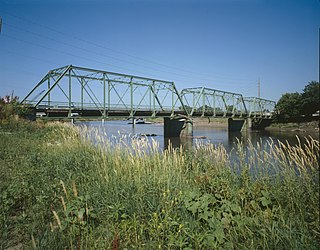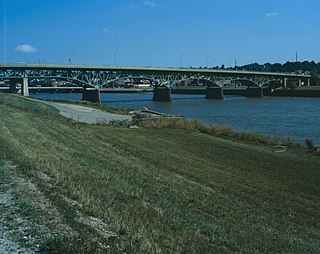
A water tower is an elevated structure supporting a water tank constructed at a height sufficient to pressurize a water distribution system for the distribution of potable water, and to provide emergency storage for fire protection. Water towers often operate in conjunction with underground or surface service reservoirs, which store treated water close to where it will be used. Other types of water towers may only store raw (non-potable) water for fire protection or industrial purposes, and may not necessarily be connected to a public water supply.

CB&I was a large engineering, procurement and construction (EPC) company with its administrative headquarters in The Woodlands, Texas. CB&I specialized in projects for oil and gas companies. CB&I employed more than 32,000 people worldwide. In May 2018 the company merged into McDermott International. McDermott struggled to integrate its acquisition of Chicago Bridge & Iron Co. On January 21, 2020, McDermott announced that it had filed for Chapter 11 bankruptcy.

The Lena Water Tower is a water tower located in the village of Lena, Illinois, United States. It was built in 1896 following two decades of problems with structure fires in the village. The current water tower is the result of a second attempt after the first structure proved to be unstable. The tower stands 122.5 feet (37.3 m) tall and is built of limestone and red brick. The current stainless steel water tank holds 50,000 gallons and replaced the original wooden tank in 1984. The site has two other structures, an old power plant building and a 100,000 US gallon reservoir. The Lena Electric Plant Building was constructed in 1905 and the reservoir completed in 1907. The Lena Water Tower was listed on the U.S. National Register of Historic Places in 1997; the reservoir was included as a contributing property to the listing.

The Southwest Fifth St. Bridge is an historic structure located in downtown Des Moines, Iowa, United States. Built in 1898 after a controversy surrounding the bidding process, it is one of the last Pratt through truss bridges left in an urban setting in Iowa. The bridge was listed on the National Register of Historic Places in 1998 as a part of the Highway Bridges of Iowa MPS.

The Allen Hazen Water Tower, also known as the Municipal Water Tower, is a historic structure located on the west side of Des Moines, Iowa, United States. It was listed on the National Register of Historic Places in 2004.

The Jefferson Street Viaduct is an historic structure located in Ottumwa, Iowa, United States. The riveted Warren deck truss bridge was completed in 1936. It was listed on the National Register of Historic Places in 1998 as a part of the Highway Bridges of Iowa MPS.

The Pittsburgh-Des Moines Steel Company, and often referred to as Pitt-Des Moines Steel or PDM was an American steel fabrication company. It operated from 1892 until approximately 2002 when its assets were sold to other companies, including Chicago Bridge & Iron Company. The company began as a builder of steel water tanks and bridges. It also later fabricated the "forked" columns for the World Trade Center in the 1960s, and was the steel fabricator and erector for the Gateway Arch in St. Louis. A number of its works are listed on the National Register of Historic Places.

The Monette Water Tower is a historic structure located at the junction of Arkansas Highway 139 and Texie Avenue in Monette, Arkansas. It was built in 1936 by the Chicago Bridge & Iron Company in conjunction with the Public Works Administration as part of a project to improve the area's water supply. The Monette Water Tower is considered a good example of a 1930s-era elevated steel water tank. It was added to the National Register of Historic Places in 2008, as part of a multiple-property listing that included numerous other New Deal-era projects throughout Arkansas.

The McCrory Waterworks is a historic site located in McCrory, Arkansas. It contains an elevated steel water tower, built in 1936 by the Chicago Bridge & Iron Company in conjunction with the Public Works Administration, which provided $39,497 in aid for the construction of the waterworks, which included the water tower, tank, and water shed. The site was added to the National Register of Historic Places in 2007, as part of a multiple-property listing that included numerous other New Deal-era projects throughout Arkansas.

The Monroe Water Tower is a historic water tower built in 1889 in Monroe, Wisconsin. It was added to the National Register of Historic Places in 2005.

The Hughes Water Tower is located on Church Street in Hughes, Arkansas. It is a metal structure consisting of four legs, sloping inward as they rise, which support a roughly cylindrical tower with bowl-shaped bottom and a conical roof. The legs are joined by reinforcing rods to provide stability. A large metal pipe connects the tank to water facilities on the ground, and there is a walkway with railing around the tank. The tower was built in 1936 by the Chicago Bridge and Iron Works Company with funding from the Public Works Administration.

The Paul–Helen Building is a historic building in downtown Iowa City, Iowa. The Chicago school building was the first part of a renewal of downtown Iowa City starting in the 1910s.

The Green Forest Water Tower is a historic water tower, located near the junction of South Springfield and East Second Streets in Green Forest, Arkansas. It consists of a metal supporting structure with four legs and cross bracing, supporting a water tank with a bowl-shaped bottom, with a water pipe in the center of the structure connecting the tank to the water system. The tank was built in 1937 by the Chicago Bridge and Iron Works Company with funding from the Public Works Administration. It is the only known surviving PWA-funded tower in Carroll County.

Grand Mound Town Hall and Waterworks Historic District, also known as Hose house, pump house, is a historic district located in Grand Mound, Iowa, United States. It was listed on the National Register of Historic Places in 2001. The district is composed of two buildings and the town's water tower.

Red Bridge is a historic structure located northeast of Postville, Iowa, United States. It spans the Yellow River for 128 feet (39 m). The Allamakee County Engineer designed the timber Pratt through truss structure, and it was erected by a local contractor named A.L. Powell in 1920. Built for $2,304.74, it is composed of timber compression members and forged iron tension members. The structural steel was provided by the Worden-Allen Company of Milwaukee, and City Lumber provided the timbers. At some point it was abandoned and the timber deck and stringers were removed. It is the last uncovered timber truss bridge remaining in Iowa. The bridge was listed on the National Register of Historic Places in 1998.

Elmina Wilson (1870–1918) was the first American woman to complete a four-year degree in civil engineering. She went on to earn the first master's degree in the field and then became the first woman professor to teach engineering at Iowa State University (ISU). Her first project was as an assistant on the design of the Marston Water Tower on the ISU campus. After teaching for a decade at the school, she moved to New York City to enter private practice. Wilson worked with the James E. Brooks Company, skyscraper design firm Purdy and Henderson, and the John Severn Brown Company.

The Ogilvie Watertower is a historic water tower in Ogilvie, Minnesota, United States, built in 1918. It was listed on the National Register of Historic Places in 1980 for having local significance in the themes of engineering and social history. It was nominated for being a rare surviving example of Minnesota's earliest reinforced concrete water towers and a symbol of the local infrastructure improvements that enabled the organization of Ogilvie's fire department.

The Harper and McIntire Company Warehouse, also known as Smulekoff's Warehouse, is a historic building located in Cedar Rapids, Iowa, United States. Harper and Mcintire was a wholesale hardware business that was established in Ottumwa, Iowa in 1867. A branch warehouse in Cedar Rapids was begun in 1921. The four-story, brick, Commercial structure was designed by the Minneapolis architectural firm of Croft and Boerner. Cedar Rapids contractor Theodore Stark & Company and Ferro Concrete Construction Company of Cincinnati were responsible for construction. The building was completed in 1922 in an industrial area where spur lines connected it to the Fourth Street Railroad Corridor. It was originally designed as a seven-story building, but by the time it was put out for bid it was reduced to four-stories with a two-story tower that enclosed a water tank. Two additions were added to be building that facilitated the change to shipping by truck. The east side addition was completed in the 1940s, and the west side addition (1962) was built where the railroad spur track had been located. Smulekoffs Furniture Company took over the building in 1981 and remained until 2014 when they went out of business. The building was listed on the National Register of Historic Places in 2015.

The Colony Tower Complex is a decorative water tower, with a gate and gatehouse, located at 6503 Dyke Rd. (M-29) in Pearl Beach, Michigan. The tower was listed on the National Register of Historic Places in 1994, and the gatehouse joined it in 1995.

Towering over the City of Bunnell is the city's most visible and iconic landmark: the City of Bunnell elevated steel water tower. The water tower is located at 100 Utility Street, Bunnell, FL 32110. It was built in 1926 by Chicago Bridge & Iron Company as part of a new waterworks system for Bunnell that went into operation in December 1927 and has been providing water to residents and local businesses to this day. The water tower is 110 feet high and its elevated steel tank holds 75,000 gallons of water. The elevated steel water tank has a conical top, Horton hemispherical bottom and is supported by four steel columns (legs) and reinforced with steel cross braces. The east and west sides of the elevated tank have black painted signage that read “City of Bunnell, Crossroads of Flagler County”






















